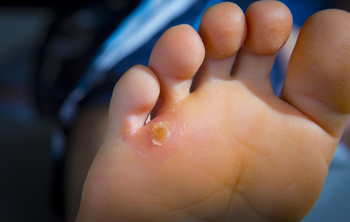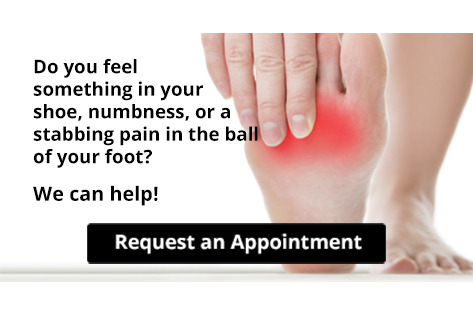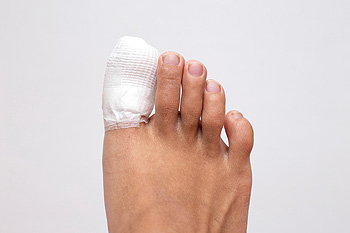Connect With Us
Blogs
Blog
Stretching and Flat Feet
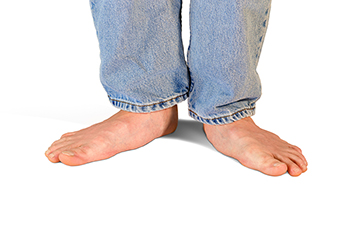 Many patients with flat feet have found that frequently performing specific exercises may help their feet feel better. The pain from this condition is normally felt in the bottom of the foot, and it can make accomplishing daily activities difficult to complete. Flat feet, or fallen arches, can be a result of overstretched tissues which may lead to additional foot conditions. Stretching the heel can help the entire foot. This can be done by standing with your hands resting against a wall. As one leg is extended behind you, a gentle stretch can be felt in the Achilles tendon when the body is pushed toward the wall. Research has indicated that rolling the heel on a tennis ball can also help to strengthen the arch. If you have flat feet, please speak with a podiatrist to learn about what exercises and stretches may help your condition.
Many patients with flat feet have found that frequently performing specific exercises may help their feet feel better. The pain from this condition is normally felt in the bottom of the foot, and it can make accomplishing daily activities difficult to complete. Flat feet, or fallen arches, can be a result of overstretched tissues which may lead to additional foot conditions. Stretching the heel can help the entire foot. This can be done by standing with your hands resting against a wall. As one leg is extended behind you, a gentle stretch can be felt in the Achilles tendon when the body is pushed toward the wall. Research has indicated that rolling the heel on a tennis ball can also help to strengthen the arch. If you have flat feet, please speak with a podiatrist to learn about what exercises and stretches may help your condition.
Flatfoot is a condition many people suffer from. If you have flat feet, contact Dr. Michael D. Garvin from Florida. Our doctor will treat your foot and ankle needs.
What Are Flat Feet?
Flatfoot is a condition in which the arch of the foot is depressed and the sole of the foot is almost completely in contact with the ground. About 20-30% of the population generally has flat feet because their arches never formed during growth.
Conditions & Problems:
Having flat feet makes it difficult to run or walk because of the stress placed on the ankles.
Alignment – The general alignment of your legs can be disrupted, because the ankles move inward which can cause major discomfort.
Knees – If you have complications with your knees, flat feet can be a contributor to arthritis in that area.
Symptoms
- Pain around the heel or arch area
- Trouble standing on the tip toe
- Swelling around the inside of the ankle
- Flat look to one or both feet
- Having your shoes feel uneven when worn
Treatment
If you are experiencing pain and stress on the foot you may weaken the posterior tibial tendon, which runs around the inside of the ankle.
If you have any questions please feel free to contact our offices located in Port St. Lucie, FL . We offer the newest diagnostic and treatment technologies for all your foot and ankle needs.
Read more about FlatfootCuboid Syndrome and Running
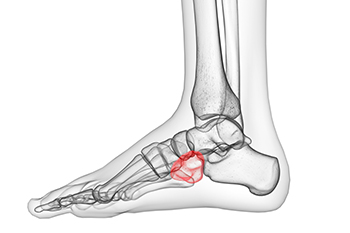 Cuboid syndrome is a condition in which the cuboid bone, located near the center of the foot, becomes displaced. If you’re a runner, this is a problem that you should watch out for. Your feet absorb shock up to two and a half times your body weight when you run. When all of the foot bones are properly aligned, your feet can absorb the shock without much discomfort. However, when the cuboid bone is displaced the feet can’t absorb shock as efficiently leading to foot pain, swelling, reduced range of motion, and difficulty bearing weight on the affected foot. Cuboid syndrome may occur in conjunction with an ankle sprain, or it can be caused by poor foot biomechanics or injury. If you are experiencing any foot pain please seek the care of a podiatrist.
Cuboid syndrome is a condition in which the cuboid bone, located near the center of the foot, becomes displaced. If you’re a runner, this is a problem that you should watch out for. Your feet absorb shock up to two and a half times your body weight when you run. When all of the foot bones are properly aligned, your feet can absorb the shock without much discomfort. However, when the cuboid bone is displaced the feet can’t absorb shock as efficiently leading to foot pain, swelling, reduced range of motion, and difficulty bearing weight on the affected foot. Cuboid syndrome may occur in conjunction with an ankle sprain, or it can be caused by poor foot biomechanics or injury. If you are experiencing any foot pain please seek the care of a podiatrist.
Cuboid syndrome, also known as cuboid subluxation, occurs when the joints and ligaments near the cuboid bone in the foot become torn. If you have cuboid syndrome, consult with Dr. Michael D. Garvin from Florida. Our doctor will assess your condition and provide you with quality foot and ankle treatment.
Cuboid syndrome is a common cause of lateral foot pain, which is pain on the outside of the foot. The condition may happen suddenly due to an ankle sprain, or it may develop slowly overtime from repetitive tension through the bone and surrounding structures.
Causes
The most common causes of cuboid syndrome include:
- Injury – The most common cause of this ailment is an ankle sprain.
- Repetitive Strain – Tension placed through the peroneus longus muscle from repetitive activities such as jumping and running may cause excessive traction on the bone causing it to sublux.
- Altered Foot Biomechanics – Most people suffering from cuboid subluxation have flat feet.
Symptoms
A common symptom of cuboid syndrome is pain along the outside of the foot which can be felt in the ankle and toes. This pain may create walking difficulties and may cause those with the condition to walk with a limp.
Diagnosis
Diagnosis of cuboid syndrome is often difficult, and it is often misdiagnosed. X-rays, MRIs and CT scans often fail to properly show the cuboid subluxation. Although there isn’t a specific test used to diagnose cuboid syndrome, your podiatrist will usually check if pain is felt while pressing firmly on the cuboid bone of your foot.
Treatment
Just as the range of causes varies widely, so do treatments. Some more common treatments are ice therapy, rest, exercise, taping, and orthotics.
If you have any questions, please feel free to contact our offices located in Port St. Lucie, FL . We offer the newest diagnostic and treatment technologies for all your foot care needs.
Read more about Cuboid Syndrome
Treatment for Corns
Corns are small lumps that can form on the feet in response to friction. They may be hard or soft, depending on their location. Hard corns might form on the tops of the toes or on the soles of the feet, while soft corns usually form in between the toes. Though they are typically not serious, corns can be annoying and uncomfortable. A variety of home treatments can be used to find relief. For example, soaking your feet and rubbing dry areas of skin with a wet pumice stone can help soften hard corns. Moisturizing your feet regularly and wearing comfortable, well-fitted shoes can help prevent corns from developing. If you have painful, inflamed corns, or if you are diabetic, it is suggested that you see a podiatrist for proper treatment.
Corns can make walking very painful and should be treated immediately. If you have questions regarding your feet and ankles, contact Dr. Michael D. Garvin of Florida. Our doctor will treat your foot and ankle needs.
Corns: What Are They? And How Do You Get Rid of Them?
Corns are thickened areas on the skin that can become painful. They are caused by excessive pressure and friction on the skin. Corns press into the deeper layers of the skin and are usually round in shape.
Ways to Prevent Corns
There are many ways to get rid of painful corns such as:
- Wearing properly fitting shoes that have been measured by a professional
- Wearing shoes that are not sharply pointed or have high heels
- Wearing only shoes that offer support
Treating Corns
Although most corns slowly disappear when the friction or pressure stops, this isn’t always the case. Consult with your podiatrist to determine the best treatment option for your case of corns.
If you have any questions please feel free to contact our offices located in Port St. Lucie, FL . We offer the newest diagnostic and treatment technologies for all your foot and ankle needs.
Read more about Corns and CallusesWhat Are Sesamoids?
The sesamoid bones are located in the ball of the foot, just behind the big toe. These two tiny pea-sized bones support tendons in the feet and allow downward motion of the big toe. When the sesamoids are inflamed it is known as sesamoiditis. This condition usually arises as a result of a sudden injury that bends the big toe upwards. People who participate in sports that put stress on the sesamoid bones, such as football, soccer, and dance, are at an increased risk of sesamoid injuries. Suddenly increasing the intensity of your workouts or wearing ill-fitted shoes or shoes with excessively high heels can also make sesamoiditis more likely. Symptoms of this condition include pain under the ball of the foot, a restricted range of motion in the big toe, and a popping sensation in your big toe when you walk. If you suspect that you may have sesamoiditis, please seek the care of a podiatrist.
Sesamoiditis is an unpleasant foot condition characterized by pain in the balls of the feet. If you think you’re struggling with sesamoiditis, contact Dr. Michael D. Garvin of Florida. Our doctor will treat your condition thoroughly and effectively.
Sesamoiditis
Sesamoiditis is a condition of the foot that affects the ball of the foot. It is more common in younger people than it is in older people. It can also occur with people who have begun a new exercise program, since their bodies are adjusting to the new physical regimen. Pain may also be caused by the inflammation of tendons surrounding the bones. It is important to seek treatment in its early stages because if you ignore the pain, this condition can lead to more serious problems such as severe irritation and bone fractures.
Causes of Sesamoiditis
- Sudden increase in activity
- Increase in physically strenuous movement without a proper warm up or build up
- Foot structure: those who have smaller, bonier feet or those with a high arch may be more susceptible
Treatment for sesamoiditis is non-invasive and simple. Doctors may recommend a strict rest period where the patient forgoes most physical activity. This will help give the patient time to heal their feet through limited activity. For serious cases, it is best to speak with your doctor to determine a treatment option that will help your specific needs.
If you have any questions please feel free to contact our offices located in Port St. Lucie, FL . We offer the newest diagnostic and treatment technologies for all your foot and ankle needs.
Read more about SesamoiditisA Common Symptom of Tarsal Tunnel Syndrome
 The tarsal tunnel is an area of the foot that is found below that ankle, and if it becomes inflamed as a result of an injury, tarsal tunnel syndrome may develop. This is caused by nerve that is located inside of the tarsal tunnel, called the tibial nerve, becoming pressed. A common symptom that is associated with this condition can consist of a burning sensation under the foot, and it could radiate to the toes and the heels. Walking may intensify this ailment, as it causes pressure to be put on the tibial nerve. If you have this type of pain, and it is hindering accomplishing daily activities, there are many options that are available for treatment. Please consult with a podiatrist who can recommend the best type of treatment for you.
The tarsal tunnel is an area of the foot that is found below that ankle, and if it becomes inflamed as a result of an injury, tarsal tunnel syndrome may develop. This is caused by nerve that is located inside of the tarsal tunnel, called the tibial nerve, becoming pressed. A common symptom that is associated with this condition can consist of a burning sensation under the foot, and it could radiate to the toes and the heels. Walking may intensify this ailment, as it causes pressure to be put on the tibial nerve. If you have this type of pain, and it is hindering accomplishing daily activities, there are many options that are available for treatment. Please consult with a podiatrist who can recommend the best type of treatment for you.
Tarsal tunnel syndrome can be very uncomfortable to live with. If you are experiencing tarsal tunnel syndrome, contact Dr. Michael D. Garvin of Florida. Our doctor can provide the care you need to keep you pain-free and on your feet.
Tarsal Tunnel Syndrome
Tarsal tunnel syndrome, which can also be called tibial nerve dysfunction, is an uncommon condition of misfiring peripheral nerves in the foot. The tibial nerve is the peripheral nerve in the leg responsible for sensation and movement of the foot and calf muscles. In tarsal tunnel syndrome, the tibial nerve is damaged, causing problems with movement and feeling in the foot of the affected leg.
Common Cause of Tarsal Tunnel Syndrome
- Involves pressure or an injury, direct pressure on the tibial nerve for an extended period of time, sometimes caused by other body structures close by or near the knee.
- Diseases that damage nerves, including diabetes, may cause tarsal tunnel syndrome.
- At times, tarsal tunnel syndrome can appear without an obvious cause in some cases.
The Effects of Tarsal Tunnel Syndrome
- Different sensations, an afflicted person may experience pain, tingling, burning or other unusual sensations in the foot of the affected leg.
- The foot muscles, toes and ankle become weaker, and curling your toes or flexing your foot can become difficult.
- If condition worsens, infections and ulcers may develop on the foot that is experiencing the syndrome.
A physical exam of the leg can help identify the presence of tarsal tunnel syndrome. Medical tests, such as a nerve biopsy, are also used to diagnose the condition. Patients may receive physical therapy and prescriptive medication. In extreme cases, some may require surgery.
If you have any questions please feel free to contact our offices located in Port St. Lucie, FL . We offer the newest diagnostic and treatment technologies for all your foot and ankle needs.
Read more about Treating Tarsal Tunnel SyndromeFinding Pain Relief From Sever’s Disease
 The pain from the foot condition that is known as Sever's disease can cause severe discomfort, despite the fact that it typically doesn’t last long. This is an ailment that generally affects young teenagers who are physically active and involves the growth plate in the heel. It is referred to as a painful bone disorder and happens as the heel bone grows faster than the surrounding tendons and muscles. Common symptoms that many patients experience can include heel pain, swelling, tightness, and the area may appear to be bruised. Mild relief may be found when that activity that caused this ailment is temporarily ceased, and the foot is frequently elevated. It can be beneficial to strengthen the foot by performing specific calf stretches. This can help to increase the flexibility of the muscles that are connected to the heel. If your child is physically active and begins limping, it is strongly suggested that you consult with a podiatrist who can effectively treat Sever’s disease.
The pain from the foot condition that is known as Sever's disease can cause severe discomfort, despite the fact that it typically doesn’t last long. This is an ailment that generally affects young teenagers who are physically active and involves the growth plate in the heel. It is referred to as a painful bone disorder and happens as the heel bone grows faster than the surrounding tendons and muscles. Common symptoms that many patients experience can include heel pain, swelling, tightness, and the area may appear to be bruised. Mild relief may be found when that activity that caused this ailment is temporarily ceased, and the foot is frequently elevated. It can be beneficial to strengthen the foot by performing specific calf stretches. This can help to increase the flexibility of the muscles that are connected to the heel. If your child is physically active and begins limping, it is strongly suggested that you consult with a podiatrist who can effectively treat Sever’s disease.
Sever's disease often occurs in children and teens. If your child is experiencing foot or ankle pain, see Dr. Michael D. Garvin from Florida. Our doctor can treat your child’s foot and ankle needs.
Sever’s Disease
Sever’s disease is also known as calcaneal apophysitis, which is a medical condition that causes heel pain I none or both feet. The disease is known to affect children between the ages of 8 and 14.
Sever’s disease occurs when part of the child’s heel known as the growth plate (calcaneal epiphysis) is attached to the Achilles tendon. This area can suffer injury when the muscles and tendons of the growing foot do not keep pace with bone growth. Therefore, the constant pain which one experiences at the back of the heel will make the child unable to put any weight on the heel. The child is then forced to walk on their toes.
Symptoms
Acute pain – Pain associated with Sever’s disease is usually felt in the heel when the child engages in physical activity such as walking, jumping and or running.
Highly active – Children who are very active are among the most susceptible in experiencing Sever’s disease, because of the stress and tension placed on their feet.
If you have any questions, please feel free to contact our offices located in Port St. Lucie, FL . We offer the newest diagnostic and treatment technologies for all your foot and ankle injuries.
Read more about Sever's DiseaseExercises for Shin Splints
 The term “shin splints” refers to pain along the shin bone in the lower leg that is caused by overuse. They are a common problem among athletes and people who regularly engage in activities, such as as running or jogging, that put stress on their lower limbs. Fortunately, pain from shin splints can be prevented and alleviated by stretching your legs. One simple stretch that you can do is toe curls. You can do this stretch by sitting on a chair with a towel spread out on the floor in front of you. Put your feet on the towel, and using just your toes, grab the towel and lift it up. Toe curls and many other stretches can improve the flexibility and strength of the muscles and tendons in the lower legs. If you suffer from shin splints and find that your pain is severe, chronic, or interferes with your daily activities, don’t hesitate to schedule an appointment with a podiatrist near you.
The term “shin splints” refers to pain along the shin bone in the lower leg that is caused by overuse. They are a common problem among athletes and people who regularly engage in activities, such as as running or jogging, that put stress on their lower limbs. Fortunately, pain from shin splints can be prevented and alleviated by stretching your legs. One simple stretch that you can do is toe curls. You can do this stretch by sitting on a chair with a towel spread out on the floor in front of you. Put your feet on the towel, and using just your toes, grab the towel and lift it up. Toe curls and many other stretches can improve the flexibility and strength of the muscles and tendons in the lower legs. If you suffer from shin splints and find that your pain is severe, chronic, or interferes with your daily activities, don’t hesitate to schedule an appointment with a podiatrist near you.
Exercising your feet regularly with the proper foot wear is a great way to prevent injuries and build strength. If you have any concerns about your feet, contact Dr. Michael D. Garvin from Florida. Our doctor can provide the care you need to keep you pain-free and on your feet.
Exercise for Your Feet
Exercise for your feet can help you gain strength, mobility and flexibility in your feet. They say that strengthening your feet can be just as rewarding as strengthening another part of the body. Your feet are very important, and we often forget about them in our daily tasks. But it is because of our feet that are we able to get going and do what we need to. For those of us fortunate enough to not have any foot problems, it is an important gesture to take care of them to ensure good health in the long run.
Some foot health exercises can include ankle pumps, tip-toeing, toe rises, lifting off the floor doing reps and sets, and flexing the toes. It is best to speak with Our doctor to determine an appropriate regimen for your needs. Everyone’s needs and bodies are different, and the activities required to maintain strength in the feet vary from individual to individual.
Once you get into a routine of doing regular exercise, you may notice a difference in your feet and how strong they may become.
If you have any questions please feel free to contact our offices located in Port St. Lucie, FL . We offer the newest diagnostic and treatment technologies for all your foot and ankle needs.
Read more about Exercise for Your FeetPodiatrists: Experts in Foot and Ankle Care
A podiatrist is a medical professional who specializes in foot, ankle, and lower limb conditions/disorders. Podiatrists diagnose, treat, manage, and prevent various foot and ankle conditions. These can include injuries such as an Achilles tendon rupture, ankle sprain, or foot fracture. Skin and nail conditions treated may consist of athlete’s foot, plantar warts, or fungal nail infections. Some deformities foot specialists see everyday are bunions and hammertoes, and they may also see chronic conditions like arthritis, nerve damage, or peripheral artery disease. The majority of podiatrists are also very familiar with diabetic foot care, including detecting, managing, and preventing foot wounds also known as diabetic foot ulcers. If you have developed any type of foot or ankle condition, it is suggested that you schedule an appointment with a podiatrist near you.
If you are dealing with pain in your feet and ankles, you may want to seek help from a podiatrist. Feel free to contact Dr. Michael D. Garvin from Florida. Our doctor can provide the care you need to keep you pain-free and on your feet.
What Is a Podiatrist?
A podiatrist is a doctor of podiatric medicine who diagnoses and treats conditions of the foot, ankle, and related structures of the leg. Your podiatrist may specialize in a certain field such as sports medicine, wound care, pediatrics, and diabetic care. Podiatrists have the ability to become board certified through training, clinical experience, and then taking an exam.
What Do Podiatrists Do?
On a daily basis, a podiatrist may perform the following activities:
- Diagnose foot ailments such as ulcers, tumors, fractures, etc.
- Use innovative methods to treat conditions
- Use corrective orthotics, casts, and strappings to correct deformities
- Correct walking patterns and balance
- Provide individual consultations to patients
It is very important that you take care of your feet. It’s easy to take having healthy feet for granted, however foot problems tend to be among the most common health conditions. Podiatrists can help diagnose and treat a variety of feet related conditions, so it is crucial that you visit one if you need assistance.
If you have any questions please feel free to contact our offices located in Port St. Lucie, FL . We offer the newest diagnostic and treatment technologies for all your foot and ankle needs.
Read more about What is a Podiatrist?
More...
Ankle-Brachial Index and PAD
The ankle-brachial index test is a relatively quick, painless, and non-invasive screening measure used to test for the presence of peripheral artery disease (PAD). PAD is a condition in which circulation in the lower limbs is reduced, typically due to a buildup of plaque in the arteries that can cause them to narrow and harden, thereby impeding blood flow. Symptoms of PAD may include leg cramps, numbness, muscle weakness, and difficulty walking, but in its earlier stages, this condition is often asymptomatic. For this reason, it is important to get tested for PAD. People who are older and those who have a history of cardiovascular disease are especially at risk and can be tested by their podiatrist. During the ankle-brachial index test, the podiatrist measures the blood pressure at the upper arm and at the ankle, comparing the resulting numbers to form a ratio that predicts the likelihood of you having PAD. A high ankle-brachial index score can predict not only PAD, but also cardiovascular events, such as a heart attack or stroke. If you are at risk of PAD or are experiencing any symptoms, talk to your podiatrist about vascular testing today.
Vascular testing plays an important part in diagnosing disease like peripheral artery disease. If you have symptoms of peripheral artery disease, or diabetes, consult with Dr. Michael D. Garvin from Florida. Our doctor will assess your condition and provide you with quality foot and ankle treatment.
What Is Vascular Testing?
Vascular testing checks for how well blood circulation is in the veins and arteries. This is most often done to determine and treat a patient for peripheral artery disease (PAD), stroke, and aneurysms. Podiatrists utilize vascular testing when a patient has symptoms of PAD or if they believe they might. If a patient has diabetes, a podiatrist may determine a vascular test to be prudent to check for poor blood circulation.
How Is it Conducted?
Most forms of vascular testing are non-invasive. Podiatrists will first conduct a visual inspection for any wounds, discoloration, and any abnormal signs prior to a vascular test.
The most common tests include:
- Ankle-Brachial Index (ABI) examination
- Doppler examination
- Pedal pulses
These tests are safe, painless, and easy to do. Once finished, the podiatrist can then provide a diagnosis and the best course for treatment.
If you have any questions, please feel free to contact our offices located in Port St. Lucie, FL . We offer the newest diagnostic and treatment technologies for all your foot care needs.
Read more about Vascular Testing in Podiatry
Peroneal Tendon Injuries
 The peroneal tendons are two bands of tissue located in the foot, behind the outer ankle bone. They connect muscles to bones and stabilize the foot and ankle, protecting them from sprains. These important tendons can become injured in various ways. They may become inflamed (tendonitis) due to overuse, which can lead to pain, swelling, and warmth to the touch. The peroneal tendons can also tear due to overuse or trauma. A rupture may cause pain, swelling, weakness, and ankle instability. Overuse during a long period of time may cause degenerative tearing of the tendons. The tendons could also slip out of their proper positions, usually due to another injury, such as an ankle sprain. If you are suffering from ankle pain, it is strongly suggested that you see a podiatrist, who can diagnose and treat your condition.
The peroneal tendons are two bands of tissue located in the foot, behind the outer ankle bone. They connect muscles to bones and stabilize the foot and ankle, protecting them from sprains. These important tendons can become injured in various ways. They may become inflamed (tendonitis) due to overuse, which can lead to pain, swelling, and warmth to the touch. The peroneal tendons can also tear due to overuse or trauma. A rupture may cause pain, swelling, weakness, and ankle instability. Overuse during a long period of time may cause degenerative tearing of the tendons. The tendons could also slip out of their proper positions, usually due to another injury, such as an ankle sprain. If you are suffering from ankle pain, it is strongly suggested that you see a podiatrist, who can diagnose and treat your condition.
Ankle and foot injuries are common among athletes and in many sports. They can be caused by several problems and may be potentially serious. If you are feeling pain or think you were injured in a sporting event or when exercising, consult with Dr. Michael D. Garvin from Florida. Our doctor will assess your condition and provide you with quality foot and ankle treatment.
Common Injuries
The most common injuries that occur in sporting activities include:
- Achilles Tendonitis
- Achilles Tendon Rupture
- Ankle Sprains
- Broken Foot
- Plantar Fasciitis
- Stress Fractures
- Turf Toe
Symptoms
Symptoms vary depending upon the injury and in some cases, there may be no symptoms at all. However, in most cases, some form of symptom is experienced. Pain, aching, burning, bruising, tenderness, tightness or stiffness, sensation loss, difficulty moving, and swelling are the most common symptoms.
Treatment
Just as symptoms vary depending upon the injury, so do treatment options. A common treatment method is known as the RICE method. This method involves rest, applying ice, compression and elevating the afflicted foot or ankle. If the injury appears to be more serious, surgery might be required, such as arthroscopic or reconstructive surgery. Lastly, rehabilitation or therapy might be needed to gain full functionality in the afflicted area. Any discomfort experienced by an athlete must be evaluated by a licensed, reputable medical professional.
If you have any questions, please feel free to contact our offices located in Port St. Lucie, FL . We offer the newest diagnostic and treatment technologies for all your foot care needs.
Read more about Sports Related Foot And Ankle InjuriesWhat to Expect When You Break Your Toe
Your big toe is made up of two bones, and each of your little toes is made up of three. Like any other bones in the body, the bones in the toes can break or fracture due to injury. If you have broken your toe, you will likely notice pain and swelling in the toe. You may also have a discolored toenail due to blood trapped beneath the surface of the nail. In a severe, open fracture of the toe, you may see your broken toe bone poking through your skin. A podiatrist can diagnose a broken toe through a physical examination. X-rays may sometimes be used to confirm a diagnosis or determine the extent of the injury. In terms of treatment, your doctor may tape the broken toe to the toe directly next to it to protect, support, and realign the broken toe. You will likely need to rest the affected foot and wear comfortable, supportive shoes. If there is blood trapped underneath your toenail, the doctor may make a small hole in the nail to drain the blood and ease pain. If you have broken your toe, please seek the care of a podiatrist as soon as possible.
Broken toes may cause a lot of pain and should be treated as soon as possible. If you have any concerns about your feet, contact Dr. Michael D. Garvin from Florida. Our doctor will treat your foot and ankle needs.
What Is a Broken Toe?
A broken toe occurs when one or more of the toe bones of the foot are broken after an injury. Injuries such as stubbing your toe or dropping a heavy object on it may cause a toe fracture.
Symptoms of a Broken Toe
- Swelling
- Pain (with/without wearing shoes)
- Stiffness
- Nail Injury
Although the injured toe should be monitored daily, it is especially important to have a podiatrist look at your toe if you have severe symptoms. Some of these symptoms include worsening or new pain that is not relieved with medication, sores, redness, or open wounds near the toe.
If you have any questions, please feel free to contact our offices located in Port St. Lucie, FL . We offer the newest diagnostic and treatment technologies for all your foot care needs.
Read more about What to Know About a Broken Toe
